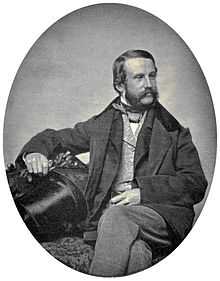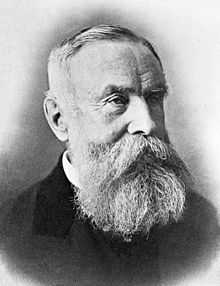Henry Jacob Bigelow


Henry Jacob Bigelow (March 11, 1818 – October 30, 1890) was an American surgeon and Professor of Surgery at Harvard University. A dominating figure in Boston medicine for many decades, he is remembered for the Bigelow maneuver for hip dislocation, a technique for treatment of kidney stones, and other innovations.[1] He was instrumental in bringing the anesthetic possibilities of ether to the attention of medical men, and rescuing the case of Phineas Gage from relative obscurity.
He was a vocal opponent of vivisection, and played a minor role in the apprehension of the culprit in the Parkman–Webster murder case.
Biography
Bigelow was born March 11, 1818 in Boston. His father, Jacob Bigelow, taught medicine at Harvard. Bigelow entered Harvard College at fifteen years old and, after a not entirely smooth undergraduate career (including an incident in which he discharged a musket in his Hollis Hall room) graduated in 1837. He studied medicine both at Harvard and at Dartmouth College (at the latter, under Oliver Wendell Holmes, Sr.), receiving his M.D. at Harvard in 1841. He was elected a Fellow of the American Academy of Arts and Sciences in 1846.[2]
His "Insensibility during Surgical Operations Produced by Inhalation" (1846), detailing the discovery of ether anesthesia, was selected by readers of the New England Journal of Medicine as the "most important article in NEJM history" in commemoration of the journal's 200th anniversary.[3][4] "Dr. Harlow's case of Recovery from the passage of an Iron Bar through the Head" (1850) brought the case of Phineas Gage out of complete obscurity into merely relative obscurity, and largely neutralized remaining scepticism about the case.[5][6]
Bigelow described the structure and function of the Y-ligament of the hip joint in great detail, and it still carries his name.[7]
In 1878 he published "Lithotrity by a Single Operation", in which he described his a technique for "the crushing and removal of a stone from the bladder at one sitting." Prior to this, surgeons would crush a bladder stone and then spend only a few minutes removing the pieces. The remaining fragments would remain for a later session for removal. This resulted in much discomfort and complications as the remaining fragments found an exit on their own. Removing the entire bladder stone in one procedure was a great advancement.
Bigelow died October 30, 1890 after an accident at his country home in Newton, Massachusetts. He is buried at Mount Auburn Cemetery.
See also
- Dr. Henry Jacob Bigelow House
- Frank Lahey MD, founder of Lahey Clinic
References
- ↑
- ↑ "Book of Members, 1780–2010: Chapter B" (PDF). American Academy of Arts and Sciences. Retrieved June 25, 2011.
- ↑ "Insensibility during Surgical Operations Produced by Inhalation". Boston Med Surg J 35: 309–317. 1846. doi:10.1056/NEJM184611180351601.
- ↑ The 'most important' NEJM article ever published. advisory.com. 2012-11/-0
- ↑ "Dr. Harlow's case of Recovery from the passage of an Iron Bar through the Head". American Journal of the Medical Sciences 20: 13–22. 1850. doi:10.1177/0957154X9300401407.
- ↑ "Bibliographical Notice". Boston Medical & Surgical Journal. 3 n.s. (7): 116–7. March 18, 1869.
- ↑ Rutkow, Ira M. (1988). The History of Surgery in the United States, 1775–1900. Norman Publishing. p. 259. ISBN 0-930405-02-1.
Bibliography
| Wikimedia Commons has media related to Henry Jacob Bigelow. |
- Harrington, Thomas Francis (1905). Mumford, James Gregory, ed. The Harvard Medical School: A History, Narrative and Documentary. 1782–1905. Lewis Publishing Company. pp. 835,853,858.
- Bigelow, Henry (November 18, 1846). "Insensibility during Surgical Operations Produced by Inhalation". Boston Med Surg J 35 (16): 309–317. doi:10.1056/NEJM184611180351601.
|